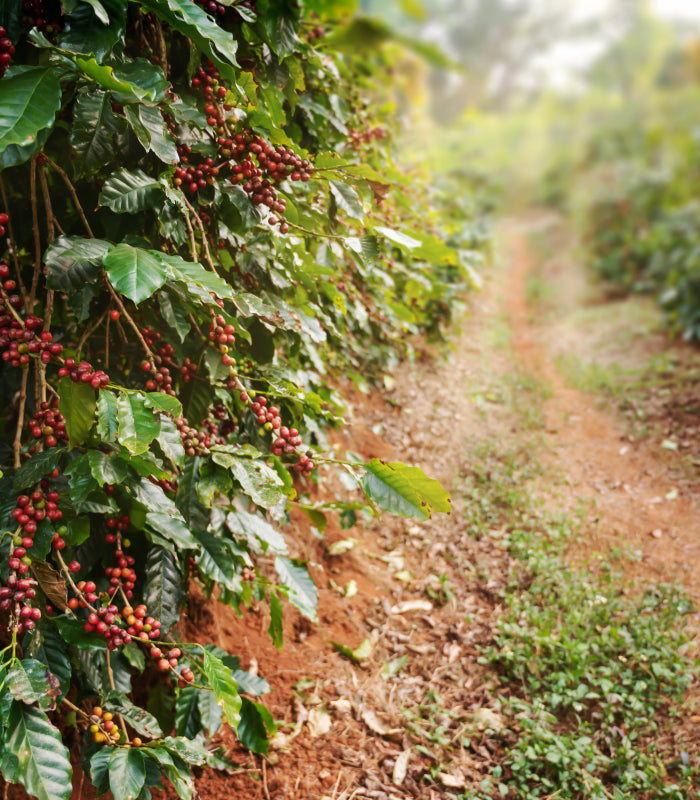Description
Description
Brew Advice
Brew Advice

Always fresh
For incomparable taste
We roast several times a week.

Secure payment
Choose from a variety of
secure payment options.

FAST DELIVERY
Safe and reliable with DHL
shipped. Directly to your home.
roasting
Espresso Roasting
Our espresso roasts are usually roasted darker and slower than our filter or omni roasts. However, this does not always apply to lighter variants, which are roasted more slowly but not necessarily darker. This method breaks down more acids and gives the coffee a fuller body. Although the crema is not a direct quality indicator, lighter roasts are characterized by a lighter and thinner crema that contains natural bitter substances. Ideal for portafilters, stovetop coffee pots and sometimes also for fully automatic machines .
Medium roast
Our medium roast, roasted for 9 to 11 minutes , offers a balanced blend of light roasted aromas and a prominent balance of body and sweetness. This roast is well suited for medium espresso and fully automatic machines .

processing
Washed Process
In the so-called washed process (or wet processing), the coffee cherries are thoroughly washed after harvest and sorted by size using various sorting channels. Larger and heavier beans are considered to be of higher quality. The pulp is removed and the beans are fermented in water tanks. After fermentation, the remaining layer of mucilage is completely washed off . The coffee beans (the kernels of the coffee cherries) are then dried in the sun on so-called African Beds , although some farms also use special greenhouses that function like greenhouses and protect the beans from the weather. The process ends with a final finishing in the dry mill , where the beans are usually graded.
Honey Process
The Honey Process is similar to the Washed Process in that the pulp is also removed (pulped). However, the mucilage remains on the beans and dries with them in the sun, giving them a honey-like appearance - hence the name. Here too, the beans are preferably dried on African Beds, and some farms use greenhouses to protect them from the weather. The process is completed in the Dry Mill , where the beans are graded. There are various variants within the Honey Process:
- White Honey : Little mucilage remains on the beans, resulting in a milder flavor profile.
- Yellow Honey : More mucilage remains than in White Honey, but less than in Red Honey, giving a balanced sweetness and acidity.
- Red Honey : Even more mucilage remains on the beans, resulting in more intense sweet and fruity notes.
- Black Honey : Most of the mucilage is retained; this process requires careful handling and results in a very sweet and complex coffee.

Cultivation land
Coffee cultivation Peru
Peru is considered an important producer of organically grown coffee. The coffee farmers, often small family businesses in the Andean regions , use traditional cultivation methods that give the coffees a fine acidity and fruity notes. Peruvian coffee is known for its sweet, sometimes chocolatey or floral aromas .
Coffee cultivation Costa Rica
Costa Rica invented the Honey Process , a method that gives the beans unique sweet and smooth flavors. Coffee cultivation in Costa Rica is highly regulated, resulting in high quality and innovative processing methods . The coffees are often very balanced and have a distinct flavor profile.

Coffee specialties
Blend
A blend refers to a mixture of different types of coffee , which may come from different growing regions, countries, or even different harvests . The purpose of a blend is to create a unique flavor profile that combines the individual characteristics of each variety to produce a balanced and harmonious cup of coffee. Here are some key features and benefits of coffee blends
PreBlend – Beans are blended before roasting and used as
Blend roasted.
PostBlend – our preferred variety – is roasted separately to perfection and then mixed.
For some, it is a sign of quality when a blend looks visually perfect - beans of uniform color and size. We, on the other hand, focus on taste. For us, it is more important that a darker bean works harmoniously with a lighter one than that they are visually perfect. For us, taste is more important than aesthetics.

Types of coffee
Arabica
Arabica is the most widely consumed type of coffee in the world and is generally considered to be of higher quality compared to Robusta. Arabica coffee is characterized by a delicate flavor profile that can range from fruity to chocolatey-nutty flavors . This diversity is partly due to the variety, the country of cultivation, the soil and especially the altitude. Arabica is grown at higher altitudes, typically above 1000 meters , where the slower growing conditions encourage the development of richer and more complex flavors. However, Arabica is also more susceptible to pests and fungal diseases such as coffee rust. More recently, Arabica-Robusta hybrids have also been developed to combine the robustness of Robusta with the delicate flavor characteristics of Arabica.





